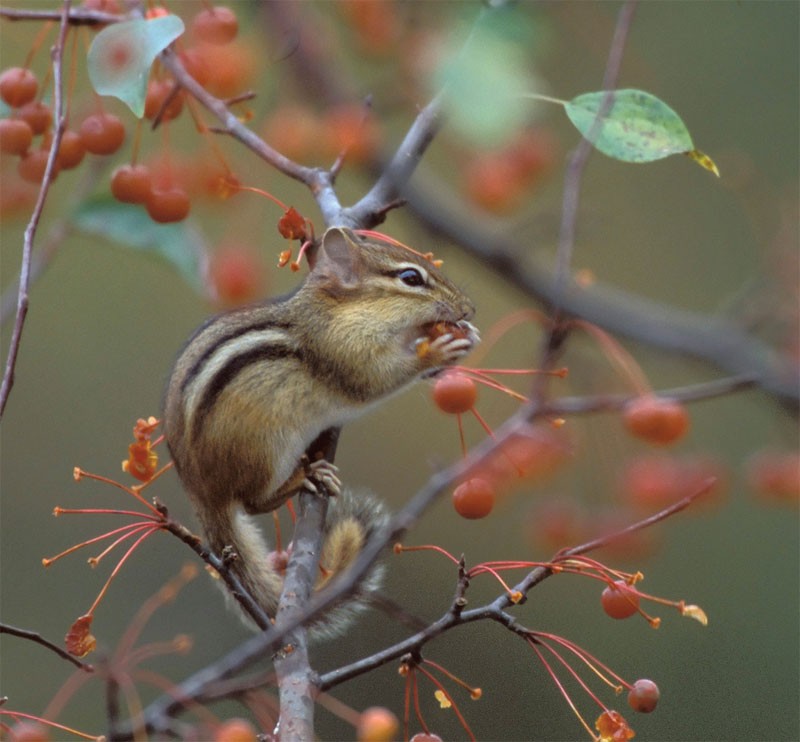
A chipmunk’s is the only life I have ever saved using CPR. The animal had become tangled in some netting around a garden at a summer camp where I was working, twisted the mesh into a noose, and was strangling. “Do something!” screamed the campers. I cut away the net, picked up the hapless chippy, and began steady, two-fingered chest compressions, trying to remember how fast I had seen a chipmunk breathe. After a few minutes, I stopped to watch. Its chest heaved. Gradually, its breathing quickened, until it suddenly sat upright and bolted into the woods.
The two words that comprise the chipmunk’s Latin name, Tamias striatus, mean, “treasurer/storer” and “striped/furrowed.” The five stripes down a chipmunk’s ruddy brown back are black or dark brown with white in between. Its face bears two stripes. A chipmunk’s wispy tail is 3 to 4 inches long.
We often see a chippy near our house grooming its small, rounded ears by rubbing its front paws against them, revealing four toes and a tiny thumb. Although “our” chippy resides under a large stone stoop, natural chipmunk habitat includes the edges of woodlands, brushy fields, stone walls, and hedgerows. Chipmunks frequently live under rocks, logs, and stumps or in fieldstone foundations.
Chipmunks use their acute sense of smell to find seeds, including acorns, hickory nuts, and hazelnuts. They also eat wild berries, grain, domestic fruits, mushrooms, pumpkins, and other squash. But chipmunks aren’t strict vegetarians. They’ll consume worms, insects, frogs, eggs, and small animals like mice, songbirds, and snakes. Chipmunk predators include snakes, hawks, foxes, cats, and people, especially disgruntled gardeners. I once even saw a red squirrel dangling a headless chipmunk between its crimson lips.
A chipmunk’s cheek pouches have been measured with a maximum capacity of 70 sunflower seeds, 31 corn kernels, or 12 acorns. The food is pushed into the cheeks through gaps between the lateral teeth. A chipmunk’s goal is to cache enough food to carry it through the winter and into the spring, storing the food in underground burrows that are about 10 feet long and 3 feet deep. In addition to a main entrance, several other passages are dug as emergency escapes but are normally kept blocked.
Chipmunks are most active in spring and autumn. They lay low in the heat of summer and eat very little. When winter arrives, they block the den door and hibernate, curled up in a dry bed of leaves. Wintering chipmunks wake once in a while to raid their pantries. The den’s living area is kept clean: droppings, nutshells, and other waste is stored in special tunnels. Dormant chippies occasionally come above ground in mild winter spells. This past March 4th, we saw one foraging near its den.
When maple sap starts to rise, male chipmunks wake up, find a female, and swish their tails in courtship. About a month later, 4 to 5 hairless young are born. Chiplets open their eyes after 4 weeks and become independent a month after that. Chipmunk adults sometimes breed again in mid-summer, with the next generation ready to start breeding the following year. On average, chipmunks survive for two or three years.
Most of us know the familiar “chip” they make when we startle them and they flee to cover with tails bolt upright. Ever curious, they soon poke their heads up again to get a good close look at the imminent threat.
Chipmunks defend territories of roughly a quarter acre in size. They do this by making a repetitive, low-range, territorial “chuck, chuck” around their feeding grounds – a circle around the burrow with a radius of about 75 feet. Chippies often scuffle with their neighbors and chase them out of their territories.
By gathering and burying seeds, chipmunks aid in the spread of trees, shrubs, and other plants. When partaking of fungi, they disperse the spores of species that aid tree roots in the absorption of nutrients. Chipmunks also spread the reproductive spores of truffles.
Although endearing and entertaining, not everyone is enamored of chipmunks, which, when eating, don’t discriminate between wild and cultivated plants. To avoid conflicts in the garden, make sure all seeds (grass seed, bird-feeder seed, vegetable seeds) are stored in chipmunk-proof containers, both protecting the seeds and preventing a large population of chipmunks from growing up around the free fare. Use 1/4-inch hardware cloth around especially prized plants to keep the chipmunks out. It may also help to maintain a gap between the edge of the woods and any ornamental plantings so that the chipmunks don’t have unbroken cover as access to flowerbeds and gardens. And finally, keep bird feeders away from buildings or other collections of ornamental plants that are likely to suffer from proximity to chipmunks.
.

